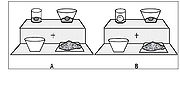
Michael Tanenhaus
Encyclopedia

Psycholinguist
A psycholinguist is a social scientist who studies Psycholinguistics. Psycholinguistics is interdisciplinary in nature and is studied by people in a variety of fields, such as psychology, cognitive science, and linguistics...
, author, and lecturer. He is the Beverly Petterson Bishop and Charles W. Bishop Professor of Brain and Cognitive Sciences and Linguistics at the University of Rochester
University of Rochester
The University of Rochester is a private, nonsectarian, research university in Rochester, New York, United States. The university grants undergraduate and graduate degrees, including doctoral and professional degrees. The university has six schools and various interdisciplinary programs.The...
. He is also the Director of the Center for Language Sciences at the University of Rochester.
Tanenhaus’s research focuses on processes which underlie real-time spoken language and reading comprehension. He is also interested in the relationship between linguistic and various non-linguistic contexts.
Biography
Michael K. Tanenhaus grew up in New York and Iowa City. He was raised in a home conducive to academics and learning. His father was a political scientist and his mother always surrounded the family with books and literature. Tanenhaus's siblings include New York Times Book Review Editor Sam TanenhausSam Tanenhaus
Sam Tanenhaus is an American historian, biographer, and journalist.-Biography:Tanenhaus received his B.A. in English from Grinnell College in 1977 and a M.A. in English Literature from Yale University in 1978. He is currently the editor of The New York Times Book Review and Week in Review...
, filmmaker Beth Tanenhaus Winsten
Beth Tanenhaus Winsten
Beth Tanenhaus Winsten is an American filmmaker, screenwriter, visual artist, and creator of the digital genre tinyBigPictureshows with channels on Youtube and Vimeo. Her work has been broadcast on the National Geographic Explorer Series, TBS, PBS, ABC affiliates among others. The National Gallery...
, and Legal Historian David S. Tanenhaus.
Tanenhaus obtained his Bachelor of Science from the University of Iowa
University of Iowa
The University of Iowa is a public state-supported research university located in Iowa City, Iowa, United States. It is the oldest public university in the state. The university is organized into eleven colleges granting undergraduate, graduate, and professional degrees...
in Speech Pathology and Audiology after a brief stint at Antioch College
Antioch College
Antioch College is a private, independent liberal arts college in Yellow Springs, Ohio, United States. It was the founder and the flagship institution of the six-campus Antioch University system. Founded in 1852 by the Christian Connection, the college began operating in 1853 with politician and...
. Tanenhaus received his Ph.D. from Columbia University
Columbia University
Columbia University in the City of New York is a private, Ivy League university in Manhattan, New York City. Columbia is the oldest institution of higher learning in the state of New York, the fifth oldest in the United States, and one of the country's nine Colonial Colleges founded before the...
in 1978. He immediately began teaching as an Assistant Professor, and then an Associate Professor at Wayne State University
Wayne State University
Wayne State University is a public research university located in Detroit, Michigan, United States, in the city's Midtown Cultural Center Historic District. Founded in 1868, WSU consists of 13 schools and colleges offering more than 400 major subject areas to over 32,000 graduate and...
. Tanenhaus joined the faculty at the University of Rochester
University of Rochester
The University of Rochester is a private, nonsectarian, research university in Rochester, New York, United States. The university grants undergraduate and graduate degrees, including doctoral and professional degrees. The university has six schools and various interdisciplinary programs.The...
in 1983. He continues to be an involved researcher and faculty member who teaches courses on language processing and advises students. He has also been the Director of the Center for Language Sciences since 2003.
Eye Tracking
Representative Research

In this study Tanenhaus looked at visual context and its effects on language comprehension. Tanenhaus wanted to investigate whether comprehension of language is informationally encapsulated or modular, as thought by many theorists and researchers including Jerry Fodor
Jerry Fodor
Jerry Alan Fodor is an American philosopher and cognitive scientist. He holds the position of State of New Jersey Professor of Philosophy at Rutgers University and is the author of many works in the fields of philosophy of mind and cognitive science, in which he has laid the groundwork for the...
.
Tanenhaus used eye-tracking software and hardware to record the movement of the subjects' eyes as they listened to phrases and manipulated objects in a scene. Tanenhaus critical stimuli used phrases that contained syntactic ambiguities, such as "Put the apple on the towel in the box," where the prepositional phrase "on the towel" is initially ambiguous between being a modifier (indicating which apple) or a goal (indicating where to put the apple). "Put the apple that's on the towel in the box" served as the control condition because "that's" signals that "on the towel" is unambiguously a modifier. Similar syntactic ambiguities had been used to show evidence for modularity within syntactic processing. Tanenhaus speculated that a visual context could be just enough to influence the resolution of these ambiguities.
When the subject is presented with the first scene, in Figure A, they become confused. We see this by the many eye movements of the subjects who are not quite sure which items to manipulate. In the second scene the subject clearly understands the sentence more easily. In this scene the pencil is replaced by another apple on a napkin. This disambiguates the phrase because the subject understands that on the towel is modifying the apple, and is not referring to a destination.
The results strongly supports the hypothesis that language comprehension, specifically at the syntactic level, is informed by visual information. This is a clearly non-modular result. These results also seem to support Just and Carpenter’s “Strong Eye Mind Hypothesis” that rapid mental processes which make up the comprehension of spoken language can be observed by eye movements.
Actions and Affordances in Syntactic Ambiguity Resolution

The results suggest that referents were assessed in terms of how compatible they were with the instructions. This supports the hypothesis that non-linguistic domain restrictions can influence syntactic ambiguity resolution. The participants applied situation specific, contextual properties to the way in which they followed these instructions. The results show that language is processed incrementally, as an utterance unfolds, and that visual information and context play a role in the processing.

